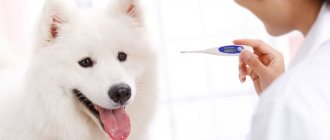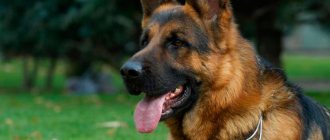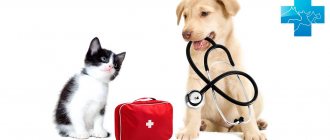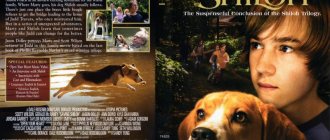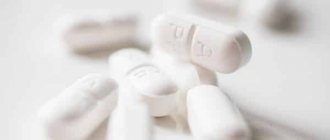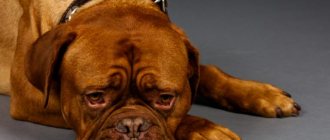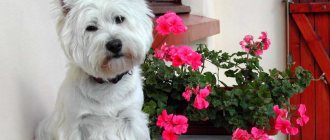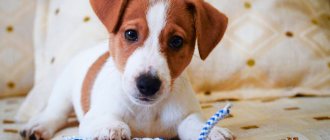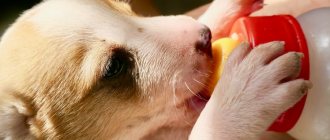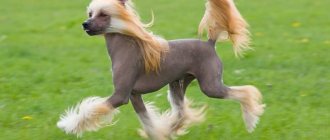09/11/2018 With the appearance of a dog in the house, many novice dog breeders realize that caring for a pet is not as simple and obvious as it might seem at first glance. And almost every moment of a pet’s life: from playing with a puppy to walking and feeding an adult animal has its own difficulties, especially if the owner thinks at least a little about the health and upbringing of his pet, and does not leave everything to chance.
Today we will look at another question that mainly concerns owners of large and medium breed dogs - what is the optimal height of a dog bowl for feeding.
What is the optimal height of a dog's bowl for feeding?
With the appearance of a dog in the house, many novice dog breeders realize that caring for a pet is not as simple and obvious as it might seem at first glance.
And almost every moment of a pet’s life: from playing with a puppy to walking and feeding an adult animal has its own difficulties, especially if the owner thinks at least a little about the health and upbringing of his pet, and does not leave everything to chance. Today we will look at another question that mainly concerns owners of large and medium breed dogs - what is the optimal height of a dog bowl for feeding.
How many dishes and what size should I buy?
For a pet, 3-4 bowls will be enough. For water, for dry food, for liquid food, for dairy products and always a spare one. Select a sippy cup for your dog separately. If the puppy eats mainly dry food, it is advisable to purchase a large water bowl, or even better, a drinking bowl. After all, dogs that eat dry food drink a lot of water. The automatic drinking bowl will be a godsend for owners who often leave the dog alone in the house. The pet will always have access to water.
Subject of heated debate
Firstly, it is worth clarifying that the height of a bowl does not mean the size of its sides (this parameter is called depth), but the height of its placement above the floor. To lift it, a variety of stands are used - from improvised means to specialized tripods.
Actually, the very use of feeding stands and the height of the dog bowl is the subject of tireless debate among amateurs and professionals.
Supporters of stands support their need with information from Soviet textbooks for breeders and the physiological characteristics of the dog’s body, while their opponents say that in nature there are no stands, and wolves, direct relatives of domestic pets, do not experience any problems with posture and curvature of their paws.
If you delve a little deeper into this issue, you can understand that both sides are a little mistaken, and using a stand does have certain advantages:
It is worth noting here that almost all of the above mainly applies to dogs of medium and large breeds, as well as long-legged puppies, since they have to bend over strongly when eating from the floor. For decorative breeds, using a stand only makes sense from the point of view of practicality and convenience.
As for the example with wolves, we should not forget that nature does not care about the health of animals - in its conditions the strongest survive. We want to do our best to prolong the life of our pets, and therefore we try to make absolutely all aspects of their existence as comfortable and safe as possible.
Location height
There are no trifles in a dog's diet. The height of the feeder is important. It is difficult for an older dog to bend over. Static tension causes joint inflammation. Puppies of breeds prone to dysplasia develop curvature of the paws and displacement of the vertebrae. Therefore, stands with adjustable feeder height are used, especially for fast-growing young animals of large breeds.
In small dogs, problems with the musculoskeletal system are less common than in giant dogs, but they cannot be completely excluded. That's why they use baby stands. It is not customary for Toys and Pekingese to place bowls on a tripod. Use low stands so that the food level is at chest height.
What is the correct height of a dog bowl?
The height of pets varies not only depending on breed and age. Moreover, even within the same breed, dogs can have different sizes. At first glance, this makes it very difficult to select the optimal height of the “feeder”, but in fact everything is quite simple - the upper edge of the bowl should be located at the level of the animal’s chest.
In some breeds, you can easily notice the protruding chest bone on the front of the chest, which should be aligned with when choosing the height of the bowl, but you can also install it “by eye” - the main thing is that the dog does not have to reach up or bend too much to the floor.
Complete set with drinking bowl
For large dogs, single dishes are considered comfortable. If you combine a feeder and a water bowl, the massive dog will throw food into a container of water. Drinking will become unsuitable. When thrown back, the granules will swell and become unattractive to eat. But for small dogs, combining a drinking bowl with a feeder is the optimal solution. A double bowl can be used for a couple of puppies.
Double bowl
An alternative option is a drinking bowl located above the food container. The dog presses the valve with its muzzle and receives water. The feeder is attached to the floor with suction cups.
Feeder with automatic drinker
How to choose a dog bowl
Every dog owner sooner or later faces a choice: which bowl to buy for his pet. The assortment presented in online stores of pet products and offline points of sale is striking in its diversity not only in sizes, but also in the materials from which dog bowls are made. Plastic, ceramics, metal and many combined materials make the buyer's eyes run wild and often make not the most rational decision when buying bowls for his four-legged friend. This article contains the most up-to-date advice on choosing dog bowls based on their breed, size and dietary preferences.
Features, purpose and necessity for dogs
First of all, when choosing a bowl, you need to pay attention to its size. It is necessary to take into account not only the growth of the pet, but also the volume of the portion he eats. What kind of food the animal eats is also important. If after feeding your dog there is a lot of food left around, you need to purchase a container with high sides. But if your pet is a small breed, it will be inconvenient for him to eat from such dishes.
The dog sits next to the bowls
Does your dog eat dry food exclusively? This means that a saucer-shaped bowl will not suit her. It is inconvenient for a dog to eat from such dishes, and in the end the food will crumble. A bowl like this is suitable if you feed your dog porridge and canned food. It is up to the owner whether to choose a dog feeding stand for small breeds, but for large dogs it is preferable to purchase just such a feeder.
Important! Dishes that were used for household purposes or an old household cup cannot be used as a bowl. Chips and cracks can injure your dog's tongue.
Floor bowls
For small breed dogs, the best option for choosing bowls would be small ceramic models. Such bowls are heavy, which will prevent your pet from “carrying” them around the floor, splashing water and scattering dry food. They are often placed on a special mat under the bowls, which leaves the floor around clean and dry.
Ceramic bowls are easy to clean and do not absorb odors, which is extremely important for picky pets. The volume of the bowl depends on the size of the dog. For example, for miniature breeds weighing up to 2 kg. Bowls with a volume of up to 0.2 liters are suitable, and for dogs whose weight is closer to 10-12 kg. you already need bowls with a volume of 0.3 to 0.5 liters.
Volume and depth
The size of the dishes depends on the weight of the dog and the type of food. When feeding wet food, dogs require 5–7% of their live weight. If the dog eats dry food, the serving size is indicated on the package.
The depth of the bowl is selected based on what the dog eats and its anatomical features. Short-faced dogs will not lower their entire muzzle to reach the bottom. From shallow dishes, pets spill soup or scatter granules. Long-haired dogs, especially bearded ones, tend to get dirty and drag leftover food all over the floor and furniture. To find out what size and depth of dish is comfortable for your dog, purchase an inexpensive trial dish.
If the animal eats willingly, does not move the feeder with its paw, or does not try to scoop food out of it, then you need to buy high-quality dishes of the same type. For untidy or mischievous pets, a sippy bowl is needed. If the dog turns the dish over, its contents will not leak out. Water is poured into the largest part of the bowl. Insert the membrane and secure with the wide edge.
A small portion of liquid is available to the pet. After lapping, the water flows into the free zone.
Racks with bowls
The benefit of tripods with bowls is the fact that the height at which the bowls are located can be adjusted, which makes this feeding option the most versatile.
At home, a dog’s skeleton develops differently than that of its wild relatives, so the issue of the health of bones and joints is extremely acute, especially in older pets. And in order to ensure that your four-legged friend’s posture does not “suffer” from endlessly tilting his head towards the coveted water or favorite “crackers”, most veterinarians recommend using stands with bowls.
Automatic feeders
What to do when the owner leaves the dog for several days? If you pour in more food, she will scatter it. Or he will eat it in a day and starve. For this situation, manufacturers have come up with automatic feeders. Dry food is poured into an inverted container. As they are eaten, the pellets enter the open part of the feeder. No matter how messy the dog is, it will not be possible to scatter food around the apartment.
Bowl with dispenser
If a special diet is prescribed for your pet and you need it to consume a certain amount of food at the same time, purchase a special plate divided into sections. Each of them opens according to the information stored in the timer. If an adult dog is left at home for the whole day, use a device for 2 feedings. The timer opens the second section in the evening.
Automatic feeder for two feedings
Bowl shape
On the top of the bowl there is a special rim, the edges of which are curved inward. It prevents water from splashing while drinking and at the same time allows you to keep your dog's face dry. These bowls are good not only at home, but also when traveling. On a train or car, you can place them next to your dog and not worry about water spilling and wetting the surface around it.
Manufacturers of pet products regularly delight dog owners with interesting new products. Likewise, in the category of items for feeding dogs, a bowl has recently appeared, which attracts with its shape and arouses the interest of even the most experienced dog breeders. The Nothmate Green interactive bowl turns any meal into an exciting adventure of getting dry food and allows it to be better absorbed in the dog’s body through the process of “slow eating”.
Such bowls not only help avoid obesity in dogs prone to this disease, but also become an object of adoration among hunting breeds of dogs who love to scour in search of the coveted last cracker.
Varieties
Often dog breeders purchase feeders made of material such as plastic. Of course, the cost may please you, but the service life of such bowls is too short. Such feeders have another drawback - they are unstable. They can also emit a very specific chemical odor, and they also absorb the odors of sour food. If you don't change the bowl in time, the smell may scare your pet away.
A more convenient option is ceramic cookware, which is durable in use. Its price is higher, but ceramics are more stable and, unlike plastic feeders, do not absorb unpleasant odors. The disadvantages include the fact that the bowls are made of fragile material and can easily break if dropped.
You can pay attention to the double feeder. True, in such a model it will be difficult to change water and food separately; you will have to change everything at once. But technology does not stand still, and manufacturers have found a way out of this situation by releasing bowls that can be removed from the stand individually.
Sippy bowls - water is supplied to such a bowl using a built-in membrane. They retain water even if the bowl is touched. The design is suitable if your pet has long ears or a beard. Can be used on the go.
The bowls on the pallet are well stable, do not slip on the floor, they are easy to remove and easy to clean.
Non-slip feeding bowl with a rubber element at the very bottom. Thanks to this, your pet will not be able to move the bowl, pour out food or pour out water.
The feeders are interactive - here you will see labyrinths and obstacles that will allow your dog to spend more time eating than usual. The pet will eat more slowly and will be able to get enough.
You can even buy a bowl with a timer. These feeders are suitable for those dog owners who are away from home for a long time.
If your pet has been prescribed a diet by your veterinarian, consider bowls with sections. You can independently set the time and quantity of food served. They are equipped with a sensor with voice notification and a heating system.
Buy an automatic waterer included - this way your pet will always have only fresh water to drink. These innovations are suitable for those owners who decide to breed dogs; they will help teach puppies to take food at the same time.
The fountain drinking bowl was created for dogs that do not like standing water in their bowl. In such a drinking bowl, water circulates, and your pet will consume the amount of liquid it needs.
You can even find a bowl for hiking on sale. It is made of waterproof fabric, which can be useful if you plan to go outdoors. Takes up little space, folds compactly and is easy to wash.
The strongest and most durable will be a metal bowl. But there is one drawback: the whole house will know about every pet’s meal. This can be avoided by using a stand for such dishes. Your pet should not lean towards the bowl; with the help of a stand it will stand at the required height for him.
The best choice for your pet
So, to choose the appropriate bowl model for your dog, you need to decide on the material, depth and shape of the bowl, suitable not only for dry food and water, but also for wet diets, which are recommended to feed your pet to maintain a healthy gastrointestinal tract. Guided by the tips presented in our article, you can easily choose exactly the bowl that is suitable for your pet, taking into account the characteristics of its breed. Remember that mats under the bowls will help keep the place where the bowl or stand is located clean and tidy, and to ensure continuity of feeding and “water supply” you can use automatic feeders and automatic drinking bowls for dogs.
Source
Materials
Dog feeders are made from the following materials:
Travel bowls are made from nylon or silicone. They are used when moving or visiting. The dishes are only suitable for dry food.
The advantage of a plastic bowl is its low cost and mobility. It doesn't smell, it's easy to clean, and it's inexpensive. However, the walls of cheap polymer absorb the odors of spoiled food. For a dog's delicate sense of smell, this is enough to refuse food.
The bowl slides on the kitchen linoleum, and the pet easily turns it over. To ensure the stability of plastic utensils, buy a bowl with an elastic band.
Feeding the dog
Feeding a dog is not only the most important aspect of proper maintenance, but also the basis of its health and longevity.
All the nuances associated with feeding a dog: from the choice of bowls and food, to the correct regimen and dosage - will be discussed in this topic.
How to do it yourself?
You can make a stand for the feeder yourself, using your imagination and available materials.
If you know how to use a welding machine, then you will not have any difficulties making a bracket from an iron tube. And you yourself will position the bowl at the adjustable height that will be comfortable for the dog. You can also use wood as a material.
It is necessary to ensure proper waterproofing; without this, the stand will quickly become unusable. After all, animals often spill water from their bowls when drinking. The structure can quickly rot and lose its presentable appearance.
A wooden stand will perfectly complement the interior of your home or apartment.
You can purchase a stand with wall mounts. There are stands on sale that hold the bowls on a tripod, with rings for metal bowls for water and food. It allows you to easily adjust the height.
This is a small, stable metal structure that can be used from an early age.
She will be able to grow up with her pet. After all, with the purchase of such a stand you will have the opportunity to keep your house clean. This saves space in your kitchen. The main thing is that this way you can avoid problems with your pet’s health.
Your dog should have two bowls. One is for dry or natural food, the other is for clean water. Your pet should swallow less air when drinking from a bowl and swallow food more easily so that it does not get stuck in the esophagus.
The ideal location for bowls for your four-legged friend is at chest level.
A tripod will help you with this. If you take into account all these points, you can easily resolve the issue of choosing a stand and feeder for your pet.
Feeding the dog. Dog bowls
The difference between the “second” and “third” bowls I recommend is more than obvious. Alas, this is exactly what one of the most common housekeeping mistakes looks like. Meanwhile, you don’t even need to go to a fortune teller to determine the future dimensions, and therefore the appetites of an actively growing pet!
As I already said, you just need to open any atlas of dog breeds to make sure that an adult male German Shepherd is a large dog, and not a medium one (and certainly not a small one, and not a dwarf one). Male weight up to 40 kg (Polishchuk F.Y., Trofimenko A.L. Kynology . P. 296). Males 30-40kg (Wikipedia). Weight 34-43 kg (Andrew de Prisco, James B. Johnson. Small Atlas of Dog Breeds. P. 465). Therefore, in the future, it is logical to buy large bowls for a large breed pet, medium bowls for a medium breed pet, small ones for a small breed pet, etc.
With such a simple and logical approach, in the future the need to replace bowls is completely eliminated, and therefore unnecessary, unnecessary expenses. Because a fast-growing puppy doesn’t care which bowl he eats from. But an adult dog is far from indifferent to the same thing. Indeed, in case of emergency, a large bowl bought, so to speak, “for growth” for a completely tiny puppy, can simply be slightly tilted. But if the portion for an adult dog is larger than a bowl, and the food spills over the edges, then this is already a problem with many unpleasant consequences... An even more obvious problem is if an overgrown pet’s muzzle simply does not fit into the bowl...
? The right bowls for growth.
? The bowls are already frankly too small, although the heads of these guys still grow and grow.
Therefore, in order to correctly decide on the size of a dog bowl, you need...
Estimate the amount of food that a future adult should eat per day. The fact is that many adult dogs eat only once a day. This means that the bowl should, if necessary, easily fit the entire daily portion.
? To determine portions, we use the diet chart on the food bag.
As practice shows, on average, dogs, especially those that are actively growing or training intensively, eat 1.5 - 2 times more food than the amount indicated on the package. Therefore, we immediately and boldly multiply the recommended norm by 2.
When feeding a dog correctly (!), after it has eaten, there should still be some food left in the bowl. This indicates that the dog has completely satisfied its appetite. This means that we further increase the received portion of feed by about 1/3, that is, we multiply it by 1.33. The volume of food in milliliters (a measure of volume) is on average 2 times its weight in grams. Therefore, we multiply the resulting weight by 2.
Thus, the formula for calculating the maximum volume of a bowl depending on the weight of the dog is: recommended portion x2x1.33x2x1.33 or recommended portion x7.08;
Memo to the owner of a Labrador puppy
CONGRATULATIONS! You have become not just the owner of a puppy, which very soon will turn from this small, funny baby into a beautiful elegant dog, you have acquired a faithful, sincere friend for many years!
MANDATORY: Before the puppy arrives in the house, remove various small objects that the puppy can swallow. Cover telephone and electrical cords, extension cords, and antennas. Do not leave books and other objects on low coffee tables, do not scatter shoes and toiletries, piercing and cutting objects, threads, needles, medicines, chemicals, etc. If your apartment has tile, laminate or parquet floors, we highly recommend carpeting or runners.
The puppy will need:
- Equipment (collar, leash, address card)
- Feed
- Sleeping area
- Bowls
- Cage, aviary (optional)
- Toys
- Grooming tools and products (brush, nail clipper)
- Treats
- Vitamins and mineral supplements
- Flea and tick remedies
- Anthelmintic drugs.
The first thing you and your family need to remember is how to properly pick up a puppy. He is still small and his muscles and ligaments are weak, and if you pick up a puppy by the front paws, it is very easy to injure him for life. You need to take the puppy with both hands under the chest and under the seat at the same time, or from both sides, grabbing the area of the chest and shoulder blades, and not under the stomach. You should hold it tightly so that the puppy does not break free and fall to the floor. It is strictly unacceptable for a puppy to walk on the street until he has received all his vaccinations! Even one time can be enough to make your puppy sick! Also, before vaccinations, do not allow the puppy to have access to personal shoes, sniffing or licking them. Only two weeks after the last vaccination you can start walking outside with your puppy.
ARRANGEMENT OF THE PLACE The puppy’s place should be quite soft and spacious. A small mattress covered with a clean diaper or sheet, which can be changed or washed if necessary, is best suited for it. It is best to place the place so that the puppy can watch you from there. Check that it is not in a draft, and preferably not in a passageway, because... The puppy needs a lot of sleep at first.
TOYS The puppy must chew - this is required by growing teeth and you need to provide him with the appropriate items - toys, so that he does not spoil your shoes and things. These can be special rubber bones, rubber cast balls (which cannot be chewed), etc. Hollow rubber toys can be chewed and your puppy may choke on pieces. For this reason, you should avoid letting your puppy play with regular children's toys. In the room where the puppy will be, be sure to remove all small objects and electrical wires. By gnawing on wires, he can be injured by switched on electrical appliances (TV, refrigerator, charger, etc.). You should also not play with a rag with a puppy; he will not understand the difference between a rag and a curtain or tablecloth and will tear both. All chemicals should be kept out of the puppy's reach.
HYGIENE Keep the litter clean. The cleaner the bedding, the better the dog. For convenience, it is recommended to have several replaceable pillowcases for the bedding, change them periodically and wash them.
It is recommended to brush the coat with a special brush once every two days; this will help remove dirt and get rid of dead fur.
After a walk, wipe your paws and belly with a damp cloth or wash with clean water without soap. You should not wash your puppy unless absolutely necessary, only if it is very dirty. If the puppy is very dirty, you can wash it with a special zoo shampoo for puppies, rinse the coat well with water and wipe dry. After swimming, keep away from drafts.
Ears should be checked every 3-4 days and, if necessary, cleaned with a cotton swab moistened with a special ear lotion or chlorhexidine. Severe contamination of the ears indicates some problems in the baby’s body; you need to consult a doctor. Allergies (red ears or dandruff) are possible due to a change in food or excess vitamins.
Periodically trim the claws (the very tip) with special nail clippers.
Carefully monitor the condition of your baby's teeth, especially during their replacement period. If baby teeth interfere with the growth of permanent teeth, there may be problems with the puppy's bite and canines. If baby teeth do not fall out on their own, you need to contact a veterinarian to have them removed. Never pull toys out of your mouth, and do not allow them to play with a leash on the street.
If your puppy rides on his butt, the reason for this is usually inflammation of the anal glands and it is not at all necessary that it could be worms. Ask your veterinarian to show you how to clean them, so you can carry out this procedure yourself in the future.
TOILET TRAINING After sleep, the puppy has a natural need to empty its bladder and intestines; in this case, it is good to take the puppy outside (only after all vaccinations) or to a designated place in the apartment, where there is a rag, a disposable diaper, or just an old newspaper. Puppies begin to ask consciously at 4 months, but much depends on the skill and patience of the owners; they can be taught to be clean even earlier. As soon as you notice that the puppy begins to spin and sit down, you need to put him in a place prepared for this purpose and hold him for a while. In most cases, the puppy quickly gets used to using these “home comforts” and there is less dirt from the puppies.
VACCINATIONS You can only vaccinate your dog at a veterinary clinic!
It is recommended to use vaccinations from such manufacturers as MERIAL (Eurikan, PrimoDog) and INTERVET (Nobivak).
Mandatory: at 2 months: Nobivac DHPPi + Nobivac Lepto or Eurican DHPPI2-L
at 3 months: Nobivac DHPPi + Nobivac Lepto + Nobivac Rabies or Eurican DHPPI2-LR
Further annually: Nobivac DHPPi (Nobivac DHPPi) + Nobivac Lepto (Nobivac Lepto) + Nobivac Rabies (Nobivac Rabies) or Eurican ChGPPg2LB (Eurican DHPPI2-LR)
Remember that before vaccination you must get rid of worms 10 days before! If, as a result of such treatment, it is discovered that the dog has been wormed, then the treatment must be repeated and the dog must be vaccinated only after consultation with a veterinarian.
ANTI-WELM TREATMENT Drive away worms every 4-6 months and 10 days before vaccination. Follow the dosage specified in the instructions exactly. Weigh your dog and calculate the dosage. An overdose can lead to serious complications, including the death of the animal, and an insufficient dosage will not get rid of parasites. In cases of severe helminthic infestation, deworming will need to be repeated after 10 days. If there are several animals living in your house, then carry out similar activities at the same time for all of them to avoid the risk of re-infection with worms from each other.
Modern veterinary medicine can offer you the following anthelmintics:
KANIKVANTEL PLUS It is used for the prevention and treatment of dogs against round and flat helminths. Dosage: 1 tablet per 10 kg of weight. For prophylaxis, it is given once. In case of ascaris infestation, treatment with Kanikvantel Plus should be repeated after 2-3 weeks.
DRONTAL-PLUS It is used to treat dogs against round and tape helminths. Dosage: 1 tablet per 10 kg of weight. Given once.
MILBEMAX is a combined anthelmintic drug with nematocidal and cestodocidal action.
Adult dogs (unless there are special indications) are dewormed twice a year and before vaccinations. It is necessary to drive away worms from bitches 2 weeks before mating.
TREATMENT AGAINST TICKS AND FLEA Ticks and fleas can be carriers of various diseases. One of the most dangerous diseases transmitted by ticks is piroplasmosis. If veterinary care is not provided to your dog in a timely manner, your pet’s death may occur on the 3rd day of illness.
It is best to use Frontline, Advantix or Inspector spray or drops. Instructions for using this product will be given to you along with the drug at the veterinary store. Please note that the entire composition must be applied to the animal's skin and not to its fur. Processing is done regularly, approximately once a month, starting from March-April and ending in November.
FEEDING You need two bowls - one for food and one for water. One bowl of water should always be there. Don't forget to keep the water clean and fresh. The food is provided only for the duration of the meal, no more than 5-10 minutes. A healthy Labrador puppy is always hungry and refusing to eat is a reason to take a closer look at his health! If the puppy is playing around, distracted, eating poorly, or uneaten food, be sure to remove it! Under no circumstances should you coax the puppy or add anything to the food; this will lead to you “persuading” even an adult dog to eat. And as a consequence of this, the dog will be constantly thin, feeding will turn into endless agony for both you and your dog. The puppy will quickly understand that if he didn’t eat on time, the food has run out. Believe me, not a single dog has ever died of hunger near a full bowl.
Do not feed the puppy between feedings (only as a reward during training), and do not give anything from the table, otherwise soon you will constantly see in front of you during lunch a “poor, unfortunate, hungry” dog with saliva up to the floor and your own the meal will turn into torture, a piece will not fit in the throat.
It is more convenient to feed the puppy from a special stand with 2 bowls (for food and water). Bowls are set at such a height that the bottom of the bowl is at or just above the dog's elbows. The height of the stand should increase as the puppy grows.
The number of feedings depends on age:
1-2 months – 6 times a day.
2-4 months - 4-5 times a day
4-6 months - 3-4 times a day
7-12 months - 2-3 times a day
From 1 year - 2 times a day
After eating, leave the puppy alone, do not disturb him, and do not walk immediately after eating to avoid vomiting or gastric volvulus.
DRY FOOD After you have taken the puppy from the breeder, do not change its diet for a month! After the puppy adapts to its new home, if desired, it can be gradually transferred to a diet that is most acceptable to the new owner. It is best, simpler and more correct, to raise a puppy using “super premium” dry food. These foods should be selected according to the age and size of the dog. It is not recommended to save on feed and use “economy” class feed, because... they cannot provide all the needs of a growing organism. So subsequent treatment will cost much more than quality food.
There are many brands of acceptable dry food, such as Hill's, Josera, Eukanuba, Acana, Happy Dog, Pro Plan, Pronature and many others. Manufacturers produce a wide range of foods designed for dogs of different age groups and leading different lifestyles. Your puppy will initially eat the puppy food indicated on the food packaging, but pay attention to the protein and fat content of the food you choose. Foods with a high protein content are not suitable for a Labrador puppy; the optimal protein content is 23%-25%. After this, you will switch the puppy to a diet for juniors or young growing dogs, and only after that to food for adult dogs (the age category is always indicated on the food packaging).
It is not uncommon for Labradors to have an allergic reaction to one food or another. It can manifest itself as redness and excessive discharge in the ears, skin rashes, and itching. This does not mean that the food is bad, it is just not suitable for your pet. Classic hypoallergenic foods are those based on lamb, duck or sea fish.
When deciding to feed your puppy dry food, you must feed ONLY dry food, no cereals, soups, or dairy products. The above food contains everything necessary for the proper development of the puppy, and the addition, especially of protein products, will only upset the balance of nutrients in the food, which can lead to kidney and liver diseases. You can give fruits and vegetables as treats occasionally.
Until about 3 months of age, dry food for a puppy must first be soaked to a mushy state, but only with warm, not hot water. Then gradually the food is given more and more dry. At the same time, drinking water should be in the bowl at all times, even if you are soaking the food! It is better to use clean filtered water. It is not difficult to determine exactly how much food a puppy should be given on the food bag, based on the weight and age of the puppy. However, this norm is approximate; you should be guided by looking at your dog. A Labrador puppy should not be too thin, but not too fat. Excess weight puts a huge strain on the ligaments of this large, heavy, fast-growing baby.
NATURAL PRODUCTS If you decide to feed your puppy natural food, you must remember that this is a very serious and responsible decision. After all, everything that you put into your little friend from the first months of life, you will receive for life. The balance of necessary nutritional components, additives and minerals will be maintained - your family will have a strong, healthy animal, if something is missed somewhere - you will treat the dog for life. The most important rule is that you need to cook separately for the dog. Food from the owner's table is absolutely not suitable for a dog, and even more so for a small puppy. The basis for a puppy’s growth are protein foods: meat (including raw meat), dairy products, eggs. It is impossible to raise a good puppy on cereals and soups alone!
The following ratios should be observed in the diet of an adult dog:
• meat – 10-20 g per 1 kg of body weight (3-4 g/kg of crude protein);
• fat – 1-2 g per 1 kg of body weight, or 1/6 of the amount of meat;
• carbohydrates (porridge) – 5-6 g per 1 kg of body weight, or 1/2 the amount of meat.
Minerals should make up 3-5% of dry matter. For puppies these figures are 2-3 times higher.
The dog's diet should consist of 70% meat or fish, 20% vegetables, slightly stewed or slightly boiled, and only 10% cereals as a source of carbohydrates
MEAT - give the puppy raw daily in finely chopped pieces. The meat must be frozen for several days in the freezer, and then, finely chopped, scalded with boiling water. Meat should not be given in the form of minced meat, but rather chopped, since minced meat does not linger in the stomach and passes into the intestines semi-digested. Lean beef or lamb is best. Pork should not be given to dogs, because... due to its fat content, it weakens and affects the liver, in addition, pigs become infected with worms common to dogs.
INTERNAL ORGANS (rumen, udder, heart, lungs, kidneys, liver) - can be given from 6 months, replacing part of the meat. By-products must be frozen, because they may contain germs of worms.
DAIRY PRODUCTS - in first place, of course, is cottage cheese. Milk is less nutritious, poorly digestible by puppies, and often makes them weak. Kefir, yogurt and other fermented milk products are very good for your baby, as they have a good effect on digestion (especially with bifidobacteria). You should not give milk with very high fat content, but completely low-fat products are not healthy either.
EGGS are a very nutritious product, but in their pure form they are poorly digestible, since they hardly linger in the stomach. It is best to give quail eggs, because... They can be safely given raw. It is better to give a raw egg mixed with dairy products or porridge. You can feed eggs in the form of omelettes. If you regularly feed your dog meat, one egg per week is enough. (It is advisable to increase the supply of eggs for the bitch during the period of bearing and feeding puppies, and for the male during the mating period).
FISH – contains a lot of proteins, phosphorus and iodine, this wonderful product greatly diversifies a dog’s diet. Fish should be chosen of low-fat varieties and sea fish: hake, whiting, cod, etc. - and given boiled or raw, cleaned of bones. In the latter case, regular preventive anthelmintic measures are necessary.
BONES have no nutritional value. It is not uncommon for a puppy's intestines to become clogged. Boiled ones often cause constipation and colitis. Poultry (chicken, etc.) tubular bones are dangerous: they can lead to intestinal perforation. NEVER give!!!
GREATS - cannot be the basis for a puppy’s growth, but are necessary to replenish the body’s energy costs. You can give boiled rice and buckwheat. When cooking porridge, it is very useful to add carrots, cabbage, herbs, etc. Semolina, barley, pearl barley, and corn should not be given.
VEGETABLES - carrots and cabbage are useful to add to food raw - grated. You can make vegetable stews from cabbage, carrots, and zucchini. Raw fruits and berries, raw and finely chopped greens (lettuce, parsley) are good. The puppy must be accustomed to all this from an early age, and not allowed to get used to it. A small puppy can be left with whole raw fruits and vegetables - like toys (apples, carrots).
Beans, peas, and potatoes cannot be given, because... Dogs do not have enzymes that break down starch!
SWEETS - spoil appetite and disrupt digestion. Do not give it under any circumstances!
For normal digestion of food, it is also important that the puppy eats in a calm environment, without rushing.
MINERAL FEEDING When feeding a puppy with balanced super-premium dry food, no special vitamins or additives are usually required. But you should take into account the peculiarities of raising a large breed puppy and the heavy load that the puppy’s joints experience. In this regard, we consider it necessary, starting from 4 months, to add chondroprotectors to the puppy’s diet. Chondroprotectors are supplements that contain glucosamine and chondroitin, substances that help maintain and restore cartilage tissue in joints. Please remember that you should not feed your dog yourself without consulting your breeder or veterinarian.
We recommend the following chondroprotectors:
CANIAGIL - CaniAgil® tablets complement your dog's nutrition and, thanks to natural nutritional components (glucosamine and Omega-3 fatty acids), have a positive effect on the function of tissues, joints and cartilage. CaniAgil is recommended for dogs during the growth period, especially large breed dogs, dogs with increased stress on the joints.
WOLMAR Pro Bio Ga-Glikan is a synergistic (formula of mutually reinforcing action of components) chondroprotector for dogs. Application: for puppies during the growth period to strengthen the musculoskeletal system and prevent pathologies. For adult dogs during periods of increased stress (training, competitions, running), during the rehabilitation period after injuries (sprains, dislocations, bruises, etc.). For older dogs to prevent age-related degenerative changes in the joints.
CANVIT Chondro Maxi - Prescribed for preventive purposes for young dogs of large breeds, working and service dogs with a high load on the musculoskeletal system. Used for diseases of the musculoskeletal system and ligaments, hip dysplasia, osteoarthritis, as well as during the recovery period after injuries to joints and tendons
STRIDE PLUS is a highly effective drug that belongs to a new generation of chondroprotectors intended for the prevention and treatment of inflammatory and degenerative joint diseases in dogs, preventing damage to joint tissue.
QUESTIONS OF RAISING A PUPPY (for more details about raising a puppy, see here >>)
On the first night in a new place, your baby may whine a little, but, most likely, will persistently cross his paws and ask to come to your bed. Until now, his whole world was contained in the “nest” in which he was born, next to him were his mother, brothers, sisters - littermates - and suddenly, in an instant, everything changed. If you do not plan to let your dog on the bed in the future, then be patient and ignore these attempts to make you feel sorry for you. Do not allow from the first day what an adult dog cannot do in the future. The dog does not understand - today it is “possible”, but tomorrow it is “not possible”. If you give up, get ready for the fact that the new tenant will always share a sleeping place with you! To distract your baby, you can put a small soft toy on the bedding, lower your hand down from the bed so that he doesn’t feel so lonely.
Already at a very early age, you can slowly teach your puppy to follow different commands. This will make it easier to train later when you start going outside. Start with the command “Come to me!”, reward the puppy for following this command both at home and on the street. As a reward, there may be a piece of treat, a favorite toy, and most importantly, of course, do not skimp on praise. Remember, even if your puppy did something bad, but still followed the command “Come to me” and ran up to you, you should never punish the puppy! After executing this command, all “scores” for past offenses should be forgotten. Otherwise, your dog will never approach you on the street.
If you take your puppy on a leash during walks only to lead him home, he will quickly learn that “Come to me!” associated with an unpleasant termination of the walk. If it is possible to let the puppy run around without a leash, then after he has run a little, take him on a leash, walk with him, and then let him go again. This should be done several times during one walk, then there will be no problems with the leash.
In addition to practicing the command “Come to me!” These exercises will teach your dog to walk calmly on a leash. In modern cities, many dogs die under the wheels of cars. On crowded streets and alleys, a puppy and an adult dog (even a very obedient one) should only be on a leash.
A small puppy, having played, may encroach on your new shoes left in the corridor, or on the recently pasted wallpaper, leave a puddle in an undesirable place, etc. Remember, you can stop unwanted actions with your voice, under no circumstances should you spank or anything like that - to punish the puppy. He reacts very well to intonation and will understand that you are unhappy. It’s even better not to “provoke” the puppy. When leaving him at home alone, remove small and necessary things that are accessible to his teeth, especially shoes, threads, needles, etc. Raise curtains, hanging tablecloths, wires.
A puppy cannot immediately learn numerous prohibitions. Punishment for a “crime” can only be caught at the SCENE of the “crime”, at the MOMENT of its commission. If you come home and your favorite slippers are completely dismantled, the puppy jumps for joy when he sees you, and you start scolding him, he will decide what happened to him for such a stormy meeting, and he won’t even remember about the slippers.
You cannot be punished for a puddle or a pile! You just need to show that this is not good and that you are not happy (with your voice, facial expressions). The metabolism of a growing puppy is so rapid that he will still get dirty in the apartment for up to 5-6 months. If you take it out into the yard after every nap and feeding, there will be significantly fewer puddles. In the apartment, you can take the puppy to a specially designated place with a newspaper, rag or a medicine sheet intended for this purpose on the floor. If you need to leave for a long enough period of time, the puppy needs to be actively walked, stressing not only (and not so much) physically, but also mentally, fed, and then he will sleep most of the time before your arrival.
Owners of puppies need to remember that the lack of physical activity, as well as inadequate feeding at the age of up to 1.5 years, that is, during the period of intensive development, cannot be compensated for later, and such a puppy will not make a good breeding, working, or show dog !
A small puppy should walk often, but little by little, so as not to get tired. Gradually the number of walks decreases and their duration increases. By 6 months, the puppy should walk 4-5 km per day. Long walks can be taken ONLY BEFORE MEALS. The puppy will have a wonderful appetite and his back will not sag.
Puppies need to be taken out as often as possible, but do not forget - long walks only before meals, after meals you can only go out for the sake of keeping the house clean. If possible, go for walks as much as possible, and be sure to let them play with peers. When walking, do not encourage aggressiveness and pugnacity, because later, due to the quarrelsomeness trained in this way, your dog will be forced to walk alone.
EMERGENCY KIT
- Bandages, cotton swabs, sterile wipes, adhesive tape
- Scissors with blunt ends, electronic thermometer, disposable syringes for 1, 5 and 20 ml
- Chlorhexidine biglucanate (antiseptic)
- Solcoseryl or Actovegin, ointment (for speedy wound healing)
- Levomekol ointment.
- Streptocide, wound powder
- Hemostatic sponge (it stops bleeding well, sold in a regular pharmacy)
- Aluminum spray (anti-inflammatory, disinfectant, forms a dense film, has a drying effect. After washing, it is sprayed on the wound. Sold in veterinary pharmacies).
- Eye and ear vets. drops “Iris”, “Tsiprovet”, “Otibiovin”
- Gamavit (complex amino acid-vitamin veterinary preparation, amp, V/M)
- No-spa tablets or ampoules (has a pronounced antispasmodic effect)
- Sulfakamfocaine (for heart failure and anaphylactic shock)
- Cordiamine (central nervous system and cardiac stimulant)
- Suprastin, tavegil (antihistamine)
- Vaseline oil (for cleansing the gastrointestinal tract)
- Enteros-gel, smecta, polyphepan (enterosorbents)
- Hilak-forte, bifitrilak, lactobifidol (to normalize the flora of the gastrointestinal tract)
Approximate measurements of a Labrador Retriever puppy
| Age, months | Weight, kg | Height at the withers, cm | Girth chest, see | Girth heads, see | Girth muzzles, see | Length muzzles, see | Girth metacarpus, see |
| 1 | 3,5-3,8 | 23-23,5 | 37-38 | 27,5-28 | 17 | 3,5-4 | 9 |
| 2 | 7-8 | 30-32,5 | 45-46 | 29-32,5 | 20,5-22 | 4.5-5.5 | 10,5-11 |
| 3 | 12-14 | 39,5-42 | 51-56 | 34-36 | 23-24 | 6-7 | 11.5-12 |
| 4 | 17-19 | 44-46 | 60-64 | 38-39 | 24-26 | 7-8 | 11.5-12 |
| 5 | 21-22 | 48-51 | 66-68 | 41-42 | 25-27 | 7.5-8.5 | 11.5-12.5 |
| 6 | 24-26 | 50-55 | 67-70 | 42-43 | 27-28 | 7.5-9 | 11.5-12.5 |
| 7 | 26-28 | 52-56 | 69-74 | 43-44 | 28-29 | 7.5-9 | 11.5-13 |
| 8 | 28-30 | 54-57 | 70-76 | 45-46 | 28-30 | 7.5-9 | 11.5-13 |
| 9 | 30-32 | 55-59 | 70-77 | 46-48 | 28-31 | 7.5-9.5 | 11.5-13.5 |
| 10 | 30-36 | 55-59 | 70-84 | 46-55 | 28-32 | 7.5-10 | 11.5-14 |
| adult | 30-40 | 55-59 | 70-86 | 46-56 | 28-32 | 7.5-10 | 11.5-14 |
Height at the withers of Labrador retrievers: for males - 56-60 cm, for females - 51-56 cm.
Note: All measurements given are fairly approximate. Some dogs stop growing at 6 months, while others take up to a year to grow. Males are generally larger than females. Therefore, the measurements of your dog do not necessarily have to clearly coincide with the data indicated in the table, which are fairly averaged. We hope that the given height, weight and other measurements of a Labrador Retriever puppy will help puppy owners monitor the development of their dog.
Feeding the dog. Examples of calculating the volume of purchased bowls.
? Let's take branded bowls as an example.
Volume: 0.75 l 1.8 l 2.8 l 4.5 l
Weight is about 10 kg (Sokolov V., Shubkina A., Bukvareva E., edited by Prof. Severtsov A. Dogs of the world. P. 559). Up to 8kg (Wikipedia). Weight 5.5-8.5 kg (Andrew de Prisco, James B. Johnson. Small Atlas of Dog Breeds. P. 500).
That is, the Jack Russell Terrier belongs to the small dogs. The recommended portion of food for a dog weighing 10 kg (as you remember, we take the maximum weight) = 130g. 130x7.08=920.4ml. The branded standard bowls with a volume of 0.75 liters are frankly small.
Criteria for selecting stands
The stand is the basis, so its choice should be approached especially carefully. Products made from natural wood are considered the most practical and reliable. They are treated with a special paint, so they maintain high environmental friendliness and at the same time are not afraid of moisture and are easy to clean. In addition, they have such qualities as:
- sustainability;
- good fixation of the bowl;
- convenience - they have two holes for simultaneous supply of food and water;
- environmental friendliness
- light weight and compactness.
If you wish, you can buy a bowl for a shepherd separately, but basically all designs come already equipped. Particular attention should be paid to those models that have such a function as height adjustment. Although it is not always appropriate, since as the dog grows, the accessory will still have to be replaced. The height of the stand is the most important parameter. After all, only with the required location of the feeder can you minimize the load on the dog’s musculoskeletal and muscular systems. Bowls for adult pets should be at a height of 40 cm. For puppies, this figure can be 20-30 cm.
Feeding the dog. Tripod (stand) for bowls
A tripod (stand) for bowls is the next option offered for bowls.
The need for this accessory for dogs is still a subject of heated debate in the canine world. Some, foaming at the mouth, argue that the proper height of the tripod (stand) improves the dog’s posture and serves as a preventative against curvature of the forelimbs, especially in actively growing young animals. Others just as stubbornly dismiss it, saying that all this is nonsense, and in nature there are no tripods (stands) for wolves.
It is difficult for me to objectively judge who is right in this protracted confrontation of opinions, because it was not possible to fully investigate this issue. So, unlike raising/training dogs , I won’t be able to confidently say anything here. Therefore, as they say, “what you bought for is what you sold for.”
Thus, the statement about the front paws is theoretically justified, taking into account the enchondral type of ossification of numerous carpal bones. Therefore, if a dog (especially a large or giant breed) is predisposed to problems with joints, then having a tripod (stand) for bowls will undoubtedly be a good help in preventing curvature of the front limbs.
? An original owner's improvisation for Mastino: a table made from 2 upper sections of a kitchen counter made of 5 shelves, shortened to an acceptable height (both sections are adjustable in height), lasted from a puppy to old age
